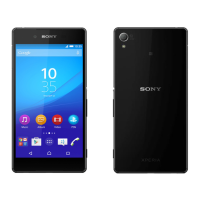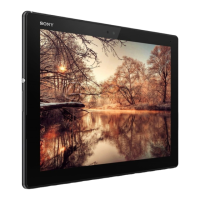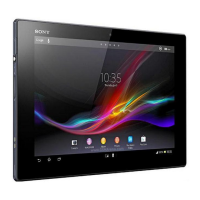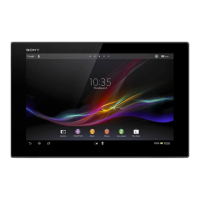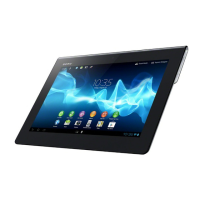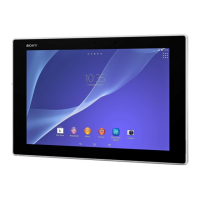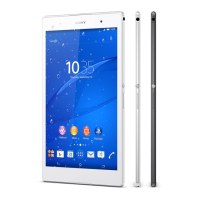Do you have a question about the Sony Xperia Z4 Tablet and is the answer not in the manual?
Provides information about the Xperia Z4 Tablet User guide for Android 6.0.
Illustrates and labels the physical components and ports of the Xperia Z4 Tablet.
Instructions for inserting a memory card and removing screen protection film.
Guidance on charging the device's battery and drying the USB port.
Ensures device protection by setting screen locks and adding Google accounts.
Details various screen lock types from weakest to strongest: Swipe, Pattern, PIN, Password.
Explains Smart Lock features like Trusted devices and Trusted places for auto-unlocking.
Describes how to locate and secure a lost device using online services like Protection by my Xperia.
Explains basic touchscreen gestures: Tapping, Touching and holding, Pinching and spreading.
Details how to activate the screen and lock/unlock the device.
Describes the Home screen layout, panes, and how to navigate the Application screen.
Introduces miniature apps for multitasking and widgets for Homescreen customization.
Instructions for downloading applications from the official Google Play store.
Guidance on enabling and downloading apps from sources other than Google Play.
Instructions for using the Google Chrome web browser for online access.
Details on turning on Wi-Fi, connecting to networks, and managing notifications.
Explains sharing a mobile data connection from an Xperia phone to a tablet.
Guidance on setting up and connecting to virtual private networks.
Setting up and manually synchronizing data with various online accounts.
Accessing corporate email, calendar, and contacts via an EAS account.
How to access and navigate the device's main Settings menu.
Adjusting ringtone, music, and media playback volumes, including vibrate mode.
Configuring interruption settings and scheduling Do Not Disturb mode.
Adjusting screen brightness, touch feedback, and idle time before screen turns off.
Using the QWERTY keyboard, gesture input, and different keyboard layouts.
Instructions for using Google voice typing to enter text instead of typing.
Selecting, cutting, copying, pasting, and sharing text using the application bar.
Customizing keyboard settings like languages, word suggestions, and layout variants.
Methods for transferring contacts using a computer, online accounts, or Bluetooth.
How to search for, filter, and view contact details in the Contacts application.
Creating new contacts, editing existing ones, and associating pictures or ringtones.
Managing favorite contacts, assigning contacts to groups, and sending contact information.
Steps to set up new and extra email accounts on the device.
Instructions for downloading, reading, sending, and forwarding email messages.
Sorting, searching, and managing email messages and folders.
Managing email accounts, inbox frequency, and Out of Office auto-replies.
Ways to transfer music files from a computer to the device.
Navigating the Music application, playing songs, and adjusting audio volume.
Managing albums, playlists, and browsing music library content.
Improving sound with Equalizer, Surround sound, and recognizing music with TrackID.
Connecting headphones, tuning channels, and switching sound output.
Saving, listening to, and removing favorite radio channels.
Switching between mono and stereo sound modes and selecting radio regions.
Capturing photos from lockscreen, touch screen, and using zoom function.
Using face detection for focus and Smile Shutter for automatic photo capture.
Adjusting geotagging, capturing modes, ISO, metering, and preview settings.
Configuring video resolution, self-timer, focus modes, and scene selection.
Navigating and viewing photos/videos, changing thumbnail size, and playing videos.
Sharing content, using photos as contact pictures/wallpapers, rotating, and deleting items.
Cropping, applying effects, adjusting light/saturation, trimming, and adjusting video speed.
Hiding photos and videos in the Hidden folder and viewing them.
Connecting the device to a TV using an MHL or HDMI cable for screen mirroring.
Using Screen Mirroring to share device screen on another display wirelessly.
Viewing or playing media content on DLNA Certified devices over a network.
Connecting USB accessories like mass storage devices or mice using a USB host adapter.
Setting up device actions based on accessory connection or time of day.
Connecting with ANT+ enabled health and fitness products for data collection.
Enabling location services for GPS and Wi-Fi based location determination.
Using Google Maps for tracking location, traffic, and getting directions.
Disabling network and radio transceivers to prevent interference.
Creating, viewing, and managing calendar events and multiple calendars.
Setting alarms, managing world clocks, stopwatch, and timer functions.
Accessing the Support application for guides, troubleshooting, and updates.
Using tools like Xperia Companion for managing device software and content.
Instructions for checking, downloading, and installing software updates.
Understanding device memory types and improving performance.
Using Xperia Companion to back up data like contacts, media files, and photos.
Making online or local backups of settings, applications, and device data.
Performing diagnostic tests to assess hardware/software issues and app performance.
Forcing a restart, shutting down, and performing a factory data reset.
Information on water and dust protection (IP65/68) and proper usage.
Referencing important information for warranty, SAR, and safety guidelines.
Notes on service availability by region, network, and potential data charges.
Copyrights, trademarks, third-party services, and licensing information.
Provides information about the Xperia Z4 Tablet User guide for Android 6.0.
Illustrates and labels the physical components and ports of the Xperia Z4 Tablet.
Instructions for inserting a memory card and removing screen protection film.
Guidance on charging the device's battery and drying the USB port.
Ensures device protection by setting screen locks and adding Google accounts.
Details various screen lock types from weakest to strongest: Swipe, Pattern, PIN, Password.
Explains Smart Lock features like Trusted devices and Trusted places for auto-unlocking.
Describes how to locate and secure a lost device using online services like Protection by my Xperia.
Explains basic touchscreen gestures: Tapping, Touching and holding, Pinching and spreading.
Details how to activate the screen and lock/unlock the device.
Describes the Home screen layout, panes, and how to navigate the Application screen.
Introduces miniature apps for multitasking and widgets for Homescreen customization.
Instructions for downloading applications from the official Google Play store.
Guidance on enabling and downloading apps from sources other than Google Play.
Instructions for using the Google Chrome web browser for online access.
Details on turning on Wi-Fi, connecting to networks, and managing notifications.
Explains sharing a mobile data connection from an Xperia phone to a tablet.
Guidance on setting up and connecting to virtual private networks.
Setting up and manually synchronizing data with various online accounts.
Accessing corporate email, calendar, and contacts via an EAS account.
How to access and navigate the device's main Settings menu.
Adjusting ringtone, music, and media playback volumes, including vibrate mode.
Configuring interruption settings and scheduling Do Not Disturb mode.
Adjusting screen brightness, touch feedback, and idle time before screen turns off.
Using the QWERTY keyboard, gesture input, and different keyboard layouts.
Instructions for using Google voice typing to enter text instead of typing.
Selecting, cutting, copying, pasting, and sharing text using the application bar.
Customizing keyboard settings like languages, word suggestions, and layout variants.
Methods for transferring contacts using a computer, online accounts, or Bluetooth.
How to search for, filter, and view contact details in the Contacts application.
Creating new contacts, editing existing ones, and associating pictures or ringtones.
Managing favorite contacts, assigning contacts to groups, and sending contact information.
Steps to set up new and extra email accounts on the device.
Instructions for downloading, reading, sending, and forwarding email messages.
Sorting, searching, and managing email messages and folders.
Managing email accounts, inbox frequency, and Out of Office auto-replies.
Ways to transfer music files from a computer to the device.
Navigating the Music application, playing songs, and adjusting audio volume.
Managing albums, playlists, and browsing music library content.
Improving sound with Equalizer, Surround sound, and recognizing music with TrackID.
Connecting headphones, tuning channels, and switching sound output.
Saving, listening to, and removing favorite radio channels.
Switching between mono and stereo sound modes and selecting radio regions.
Capturing photos from lockscreen, touch screen, and using zoom function.
Using face detection for focus and Smile Shutter for automatic photo capture.
Adjusting geotagging, capturing modes, ISO, metering, and preview settings.
Configuring video resolution, self-timer, focus modes, and scene selection.
Navigating and viewing photos/videos, changing thumbnail size, and playing videos.
Sharing content, using photos as contact pictures/wallpapers, rotating, and deleting items.
Cropping, applying effects, adjusting light/saturation, trimming, and adjusting video speed.
Hiding photos and videos in the Hidden folder and viewing them.
Connecting the device to a TV using an MHL or HDMI cable for screen mirroring.
Using Screen Mirroring to share device screen on another display wirelessly.
Viewing or playing media content on DLNA Certified devices over a network.
Connecting USB accessories like mass storage devices or mice using a USB host adapter.
Setting up device actions based on accessory connection or time of day.
Connecting with ANT+ enabled health and fitness products for data collection.
Enabling location services for GPS and Wi-Fi based location determination.
Using Google Maps for tracking location, traffic, and getting directions.
Disabling network and radio transceivers to prevent interference.
Creating, viewing, and managing calendar events and multiple calendars.
Setting alarms, managing world clocks, stopwatch, and timer functions.
Accessing the Support application for guides, troubleshooting, and updates.
Using tools like Xperia Companion for managing device software and content.
Instructions for checking, downloading, and installing software updates.
Understanding device memory types and improving performance.
Using Xperia Companion to back up data like contacts, media files, and photos.
Making online or local backups of settings, applications, and device data.
Performing diagnostic tests to assess hardware/software issues and app performance.
Forcing a restart, shutting down, and performing a factory data reset.
Information on water and dust protection (IP65/68) and proper usage.
Referencing important information for warranty, SAR, and safety guidelines.
Notes on service availability by region, network, and potential data charges.
Copyrights, trademarks, third-party services, and licensing information.
| Display Size | 10.1 inches |
|---|---|
| Display Type | IPS LCD |
| Resolution | 2560 x 1600 pixels |
| Processor | Qualcomm Snapdragon 810 |
| CPU | Octa-core (4x1.5 GHz Cortex-A53 & 4x2.0 GHz Cortex-A57) |
| GPU | Adreno 430 |
| RAM | 3 GB |
| Internal Storage | 32 GB |
| Expandable Storage | microSD, up to 256 GB |
| Rear Camera | 8.1 MP |
| Front Camera | 5.1 MP |
| Battery Capacity | 6000 mAh |
| Operating System | Android 5.0 (Lollipop), upgradable to 6.0 (Marshmallow) |
| Dimensions | 254 x 167 x 6.1 mm |
| Water Resistance | IP68 dust/water resistant (up to 1.5m for 30 mins) |
| Weight | 393 g (LTE) |
